Tidepool Tales
Tidepool Tales
Welcome to Tidepool Tales!
We want this to be a fun and informative blog, sharing photos and observations from the Laguna Bluebelt.
Seeing the ocean’s nurseries growing and prospering is the key to restoring our coastal habitats. Knowing that marine reserves serve to shelter and nourish sea life makes looking into our tidepools even more rewarding.
Join me as we explore Laguna’s intertidal zone and it’s remarkable sea life.
We might be exploring the Tidepools, paddling in a kayak, or out in the water snorkeling or scuba diving. Although we try to be accurate with our information, we are not marine biologists. We invite you to share your knowledge in the comments.
Laguna’s intertidal zone is a dynamic environment that has many challenges to it’s inhabitants. There are natural challenges including surf, sun, sand, predators, and even flooding. Man-made challenges include water pollution, trash, trampling, collecting, ocean warming and acidification.
The photo on the right was taken the afternoon after the historic flood in Laguna last December. The flood brought a great influx of freshwater down
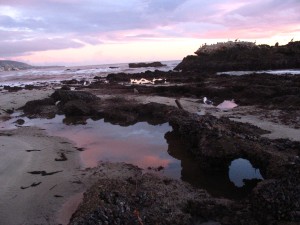 Laguna Canyon and into the tidepools near Main Beach/ Bird Rock. The flood also covered a large area of the tidepools with sand- the sand seen in this photo is normally not there. The beaches were covered with garbage and vegetation swept down the canyon. In addition, marine plants and animals including crabs and many mollusk species were washed up on the beach most dead but some still alive.
Laguna Canyon and into the tidepools near Main Beach/ Bird Rock. The flood also covered a large area of the tidepools with sand- the sand seen in this photo is normally not there. The beaches were covered with garbage and vegetation swept down the canyon. In addition, marine plants and animals including crabs and many mollusk species were washed up on the beach most dead but some still alive.
The photo below was taken about two weeks after the flood, by then the sand in the lower tidal zone was gone, but the upper zone was still covered. Finally over a month later, wave action eventually cleared out the sand.
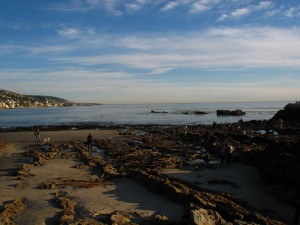
Some species seemed to have survived this event better than others. For example, sea anemones buried in sand for over one month, have survived in great numbers although in some cases their tentacles, usually a shade of green, turned white. While other species such as octopus and giant key-hole limpets have not been seen since the flood. Some mollusk species are ‘shocked’ by an influx of fresh water and will release from the rocks and then wash up on shore.
Despite these myriad challenges, life in the intertidal zone is very resilient and it is one of the easiest places to experience an abundance of diverse wildlife. This resilience can be witnessed as we observe the recovery of the tidepools from the flood. An example of this recovery was observed last weekend, when we found an animal we hadn’t seen since before the flood- the beautiful Hopkin’s Rose nudibranch.
Tidepools are our Mirrors into the Ocean.


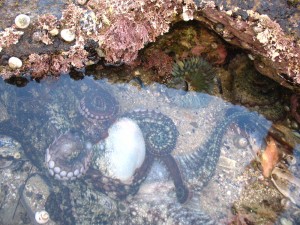
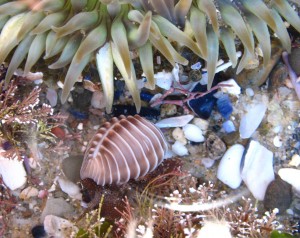
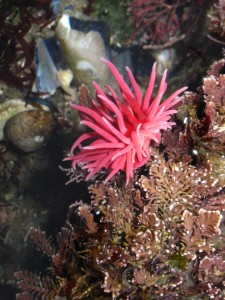


April 29, 2011 at 2:29 am
great photos sandy and thanks for sharing your perspective and enthusiasm for laguna’s tidepools.